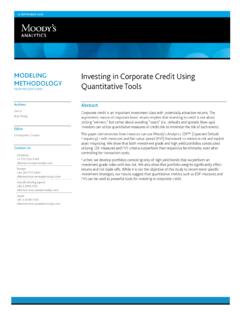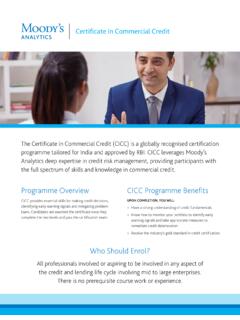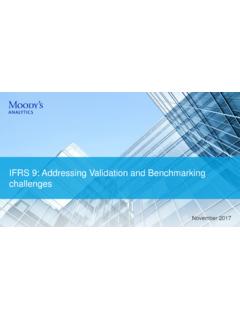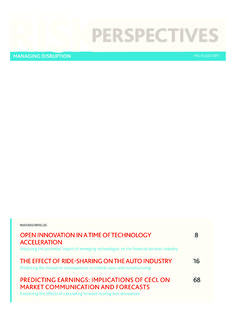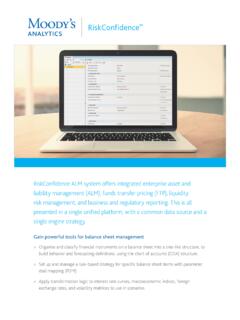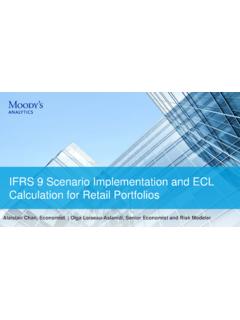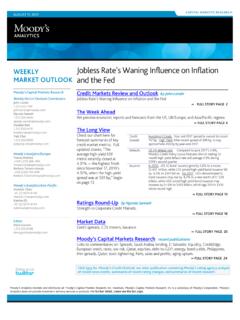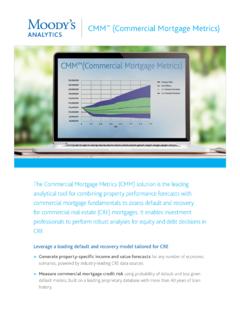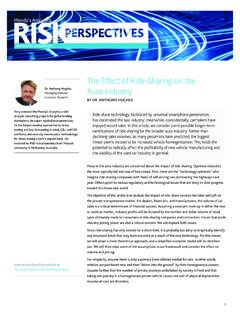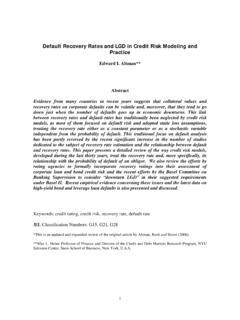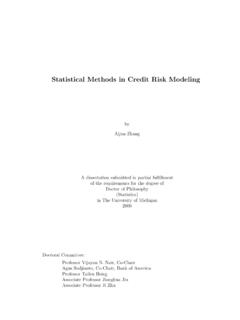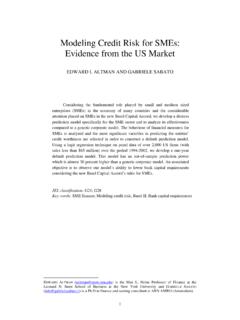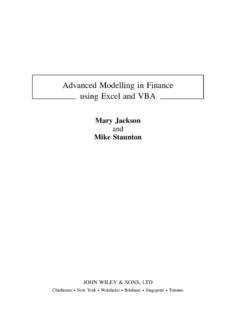Transcription of An Overview of Modeling Credit Portfolios - …
1 30 JANUARY 2013 Modeling METHODOLOGY Author Amnon Levy Contact Us Americas +1-212-5 53-165 3 cli entservi Europe + Asi a ( Excludi ng Japan) +85 2 2916 1121 cli entservi Japan +81 3 5408 4100 cli entservi An Overview of Modeling Credit Portfolios Abstract This document provides a high-level Overview of the Modeling methodologies implemented in Moody s Analytics RiskFrontier . To address the challenges faced by Credit risk or Credit portfolio managers, RiskFrontier models a Credit investment s value at the analysis date, its value distribution at some investment horizon, as well as the portfolio -referent risk of every instrument in the portfolio .
2 The approach is designed to explicitly analyze a wide range of Credit investments and contingencies, including term loans with prepayment options and grid pricing, dynamic utilization in revolving lines of Credit , bonds with put and call options, equities, Credit default swaps, retail instruments, commercial real estate loans, and structured instruments. 2013 Moody s Analytics, Inc. and/or its licensors and affiliates. All rights reserved 2 2013 Moody s Analytics, Inc. and/or its licensors and affiliates. All rights reserved Table of Contents 1 Introduction .. 5 2 S i ngle-Name Credit Instruments.
3 7 Structured Instruments .. 10 3 Measurin g the Stand-Alon e In strument Ri sk and 12 S i ngle-name Credit Instruments .. 12 Structured Instruments .. 13 4 14 5 Bringin g it All Togeth er with Monte Carlo Simulation .. 16 Re ference s .. 19 An Over view o f M o d el in g Cr ed it P or tfo l io s 2013 Moody s Analytics, Inc. and/or its licensors and affiliates. All rights reserved 3 4 2013 Moody s Analytics, Inc. and/or its licensors and affiliates. All rights reserved 1 Introduction All Credit Portfolios , whether global, regional, corporate, small and midsize enterprises (SME), commercial real estate (CRE) or retail, face uncertainty in losses.
4 For example, Figure 1 demonstrates the high corporate default and Credit card delinquency rates during economic downturns (around the recessions of 1991 and 2001). Looking at the figure, it is evident that variation in Credit quality is substantial and default risk can increase quickly and in correlation with the macro-environment. Even in the aggregate, loss variability cannot be completely eliminated by diversification. Coupled with tight lending margins, even small miscalculations in risk and pricing can undermine With this in mind, Credit risk can be substantially reduced through managed diversification.
5 As investors adopt a diversification measurement, Credit risk, and the rewards for bearing it, will ultimately be owned by those who can diversify it best. The challenge for every risk or portfolio manager is to measure and understand the economic risks in their portfolio , and ensure they are properly compensated. An active portfolio manager cannot do this without practical and conceptually sound methods for both measuring diversification, and determining portfolio holdings to minimize concentrations and maximize return in Credit Portfolios .
6 Figure 1 US corporate default and Credit card delinquency rates To address the challenges faced by Credit risk or Credit portfolio managers, RiskFrontier models each Credit investment s value at the analysis date, its distribution of returns over an investment horizon, and the joint Credit risk with all other instruments in the portfolio . The approach is designed to explicitly analyze a wide range of Credit investments and contingencies, including term loans with prepayment options and grid pricing, dynamic utilization in revolving lines of Credit , bonds with put and call options, equities, Credit default swaps, and structured instruments.
7 Moreover, the open 1 For an additional discussion, see Kealhofer and Bohn (2001). An Over view o f M o d el in g Cr ed it P or tfo l io s 2013 Moody s Analytics, Inc. and/or its licensors and affiliates. All rights reserved 5 framework provides users with tremendous flexibility in specifying the valuation approach, migration model, and correlations. As such, RiskFrontier produces a quantitative set of actionable goals for portfolio management based on a granular model that can be tailored to the specific needs of an organization.
8 The portfolio model provides accurate economic estimates of portfolio risk measured as economic capital ( , Value-at-Risk, or VaR), Unexpected Loss ( , standard deviation, or UL), or expected shortfall ( , Conditional Value-at-Risk, or CVaR). It also provides accurate estimates of portfolio -referent risk for each instrument in the portfolio , measured as risk contribution ( , contribution to portfolio UL risk) and Tail Risk Contribution ( , contribution to portfolio loss). The portfolio and instrument measures account for diversification across dimensions such as country and industry, as well as reference name concentration.
9 The model does so through a bottom-up approach that considers the following: The varying terms and conditions of each instrument ( , tenure, contingencies, and fees). Variation in the underlying reference entities. For example, the term structure of default probabilities such as the Moody s Analytics EDF (Expected Default Frequency) Credit measure. Variation in correlations across reference entities through a correlation model, such as the Moody s Analytics Global Correlation Model (GCorr), which accounts for corporate, SME, CRE, and retail correlations.
10 Measuring risk alone is insufficient when considering conceptually sound methods of active management. For example, an investment which adds a high level of risk to a portfolio may not be worth hedging; the decision should be influenced by the cost of the hedge. RiskFrontier provides an analysis that incorporates this necessary information to help the portfolio manager make practical and sound decisions. RiskFrontier provides a granular view of return and portfolio -referent risk for each investment in the portfolio . With this granular view, RiskFrontier supports action pricing, approval, position size, hedging, selling, and structuring.
